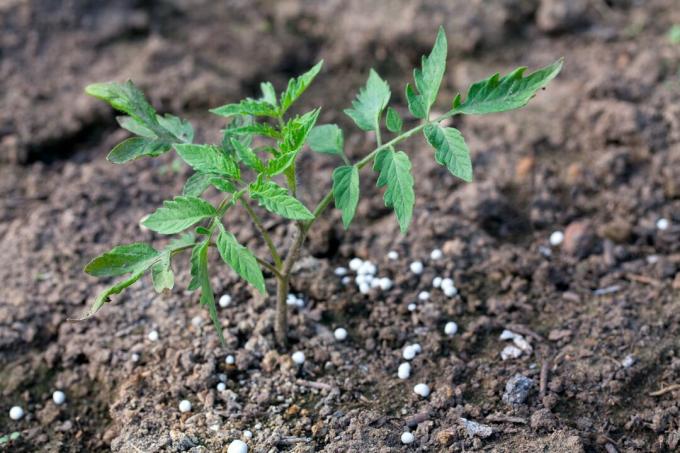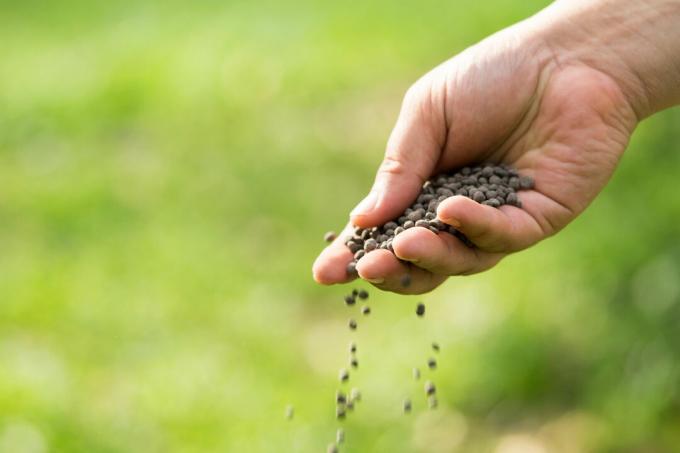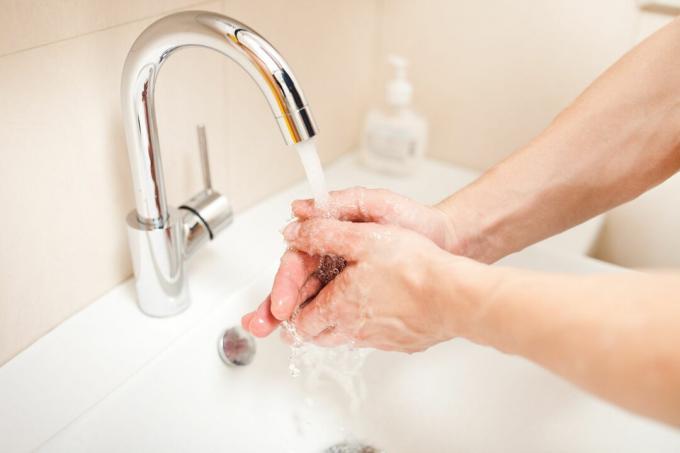Here you can find out everything about ithow blueseed is used, what the pros and cons are, and if blueseed is toxic.

Blue corn is a universal fertilizer and contains a variety of nutrients that plants generally need. However, opinions differ on this complete mineral fertilizer. Some are completely enthusiastic about Blaukorn, others don't want to hear about it. Below is everything you need to know about blue grain.
contents
-
What actually is blue grain?
- Blue Grain Recipes
- Benefits of Blue Grain
- Disadvantages of blue grain
-
Fertilizing with blue grain: application
- Which plants can blue grain be used on?
- Application recommendation for blue grain with NPK ratio 12 – 12 – 17 +2
-
Is Blue Grain Poisonous?
- Blue Grain and Pets
- Risk of confusion Blaukorn
What actually is blue grain?
Blue grain is a typical artificial fertilizer made from inorganic salts and a compound fertilizer, also known as a complete fertilizer.
complete fertilizer means that the main nutrients are nitrogen, phosphorus and potassium, which is why the term is also used NPK fertilizer can use. Nitrogen is extracted from the air industrially (using the Haber-Bosch process), potassium and phosphorus are mined in deposits. The first fertilizer of this type was called Nitrophoska and was brought onto the market by the company BASF in 1927. The advantage of mineral fertilizers such as blue grain is that they take effect very quickly. This supports the growth and flowering of the plants. A nutrient deficiency can be reacted to quickly thanks to the quick availability of the nutrients. For easier application, the blue grain fertilizer is granulated and can therefore be easily applied and distributed. Incidentally, the fertilizer is called “blue grain” because of the blue color of the fertilizer pellets.Blue Grain Recipes
The different blue grain products that are available to buy all have different compositions and NPK ratios. Cheap products often contain chloride, which can be harmful to sensitive crops. For example, potatoes, berries, beans and many other vegetable and ornamental crops are sensitive to chlorine in fertilizer.

If you want to have an adapted fertilization in your garden, you will not be able to avoid subjecting your soil to a thorough examination. Our garden soils are generally sufficiently supplied with phosphorus, if not oversupplied. Therefore, a high phosphorus content in a fertilizer is not absolutely necessary. A soil analysis shows you which nutrients are sufficiently available and which are still missing in your beds.
Benefits of Blue Grain
The advantages of blue grain (respectively of mineral fertilizers) are the following:
- Fast effectiveness
- Training is not necessary
- Nutritional information on the packaging is accurate and reliable
- Various dosage forms (liquid, solid)
Disadvantages of blue grain
Of course, there are also some arguments against blueseed, especially for gardeners who care about the health of the earth and the environment:
- Blue grain does not build up humus
- The diversity and activity of soil life is not encouraged
- Plants can be damaged and weakened by overdosing or misapplication
- Risk of excess nutrients leaching into the groundwater
So you can see that while blue grain has a few advantages, the disadvantages outweigh the disadvantages for most applications. Whether or not you use this fast-acting fertilizer in your garden is of course up to you - but you should think carefully about using it. Finally, primarily organic fertilizers such as ours offer Plantura organic lawn fertilizer adequate and more sustainable options.
Fertilizing with blue grain: application
Blaukorn should be used (if at all) in the months of March to September. The granules are scattered on the ground around the plants. The application should be done on cloudy days and in rainy weather, otherwise there is a risk that the plants will be burned. Moisture is also necessary for the fertilizer to dissolve. The grains should also not be left on the plants and their leaves, as this can also lead to burns.

It is recommended to carefully scatter the grains and then pour them in. Since the nutrients from the blue grain are available very quickly, over-fertilization can quickly occur. In addition to increased susceptibility to invasion by plant pests (for example aphids) there is also an increased risk that the excess nutrients in the soil solution will be washed out into the groundwater.
Solid blue grain can also be dissolved in water for use, but you should be careful when mixing. Two to 3 g of blue grain are sufficient for 5 liters of water. Since the grains are often difficult to dissolve, you can leave the solution overnight and stir it thoroughly before use. Thoroughly wash the watering can after use to remove residue from the bottom of the can. Blue grain granules are best used a week before sowing or before planting out. This gives the fertilizer time to take effect and dissolve in the soil. If desired, blue corn can also be used in small doses during the growing season.
Which plants can blue grain be used on?
The compound fertilizer can be used on vegetables such as tomatoes and cucumbers. Also with fruit and various shrubs as well as ornamental plants like that rhododendron you can apply blue grain. You should be careful when using blueseed on potted and flowering plants. The blue grain fertilization often increases growth and the formation of flowers is reduced.

Plants that prefer nutrient-poor soils should also not come into contact with blue corn. You can recognize nutrient-poor soils by so-called indicator plants, for example: cranberries (Vaccinium vitis-idaea), red fescue (Festuca rubra agg.) or meadow trefoil (Lotus corniculatus).
Application recommendation for blue grain with NPK ratio 12 – 12 – 17 +2
Here you will find a list of recommended amounts for different crops and comments on what you should pay particular attention to:
Blue grain for berry bushes
With berries like raspberries (Rubus idaeus) or blackberries (Rubus caesarean section Rubus) you should fertilize 80 to 150 g per m². Divide this amount over the year. It is best to fertilize two-thirds in spring and one-third after harvest. For currants (Ribes) or gooseberries (Ribes uva crispa) you can use 150 to 300 g per bush.
at strawberries (Fragaria) the application rate is 60 to 80 g per m². If used for several years, the gifts are divided into two thirds after harvest and one third in spring. If the strawberries are only used once a year, we recommend fertilizing in August before planting out.
Blue Grain for Fruit
For fruit trees that stand alone, an amount of around 80 g per m² is sufficient. Spread the fertilizer over the area that covers the treetop. For orchards, you fertilize around 50 g per m² in spring and 30 g in the months of May to June - after fruit set.

Blue grain for ornamental plants
at roses (pink) you should divide the fertilization into three parts: one third in spring, one third after the first flowering and one third at the end of July. In summer, 160 to 180 g per m² are sufficient. For ornamental flowers like tulips (Tulipa) or daffodils (Narcissus) a quantity of 60 to 80 g per m² is sufficient. To do this, use two-thirds of this amount in the fall before planting out and one-third in the spring before those flowers fade. For rhododendrons or cherry laurel (Prunus laurocerasus) you have to fertilize a little more than for the flowers, namely 60 g per m². Before vegetation starts, give two thirds of this amount and after flowering the remaining third. Young bushes should get less. In the case of rhododendrons, it is also recommended to cover the ground with pine litter.
Balcony flowers can already be supplied with fertilizer when planting. To do this, simply mix it into the potting soil. About 30 g of blue grain are used for every 10 liters of soil. But be careful when watering, because this mixture should not touch the leaves. An amount of 60 to 100 g per m² is recommended for ornamental trees such as silver or blue fir, pine or other coniferous trees, with younger trees receiving a smaller amount. If you use blue grain with magnesium, the latter will ensure that needle tanning does not occur unless it is caused by insects.
Blue Grain for Vegetables
legumes like beans (Phaseolus vulgaris) or peas (Pisum sativum) do not require very much fertilization. For peas, 40 g is enough and for beans you can use up to 80 g. For these crops, a single application before sowing is sufficient. Fruit vegetables, to which tomatoes (Solanum lycopersicum), paprika (capsicum) and cucumbers (Cucumis sativus) have a greater need for nutrients. You should therefore apply around 60 g per m² of blue grain. Half of this amount is used before sowing or before planting, and the remaining half is spread between the plants as they grow. lettuce (Lactuca sativa), Lamb's lettuce (Valerianella) or endive (Cichorium endivia) get by with a quantity of 40 to 70 g per m².

Approximately half of the amount is used before sowing or transplanting and the remaining amount is sprinkled gently between the plants during growth. Cabbage vegetables need a little more attention. You should apply a fertilizer quantity of 150 to 250 g per m² here. Use half before planting and split the remaining half into two applications four weeks apart.
Is Blue Grain Poisonous?
Since nitrate is present in the blue grain and in the water that comes into contact with the fertilizer, problems can arise. Nitrate (NO3–) itself is not toxic, but it is converted into nitrite (NO2–) and this substance leads, for example, to blue addiction (methaemoglobinemia) in small children. In the case of such cyanosis, which is delayed by blue grains, the level of methemoglobin in the blood is increased, causing a reduced supply of oxygen. Symptoms are drowsiness, headache, confusion. Ultimately, this can even lead to a coma and death. Methaemoglobinemia can be treated with an antidote (methylene blue) or with a blood transfusion. But the condition of the blood can also normalize even if harmful substances are no longer supplied. Because of this danger, especially for infants and young children, there are strict guidelines on how much nitrate can be in baby food.
If bluegrain comes into contact with your skin, you should simply wash the area with plenty of soap and water. If the blue grain comes into contact with your eyes, flush them for several minutes. To do this, hold your eye open under running water. If blueseed is swallowed, it is advisable to drink plenty of water afterwards, but do not induce vomiting. With all these recommendations, it is always important that if you experience any discomfort, you consult a doctor and take the packaging and label with you.

If you use blueseed in the garden and are concerned that your children or pets will swallow some, you should handle it with care. Do not leave the fertilizer packs open and store them in an inaccessible place. Instead of just sprinkling the seeds on the soil, work the beads into the soil and don't leave any irrigation water in which blueseed is dissolved. If you want to be on the safe side, you can do without Blaukorn and others altogether mineral fertilizers with the same risk potential. Instead, a remedy for optimal plant nutrition can primarily be found in organic fertilizers such as ours Plantura organic universal fertilizer create. In addition to being harmless to humans, animals and the environment, its production is significantly more resource-efficient and therefore more sustainable. The use of our Plantura organic fertilizer not only optimally nourishes your plants, but also promotes soil life in your garden.
Blue Grain and Pets
Like us, our pets should not eat blueseed. If you are concerned that, for example, your dog has eaten blue corn or drank water in which blue corn was dissolved, you should keep an eye on him. Symptoms of blue grain poisoning are vomiting, salivation, convulsions, shortness of breath, tremors, bloody stools and circulatory failure. In the worst case, death can occur if you do nothing. If you observe these symptoms, you should definitely take your pet to the vet. Make sure the airway is clear (do not muzzle) and remain calm. Do not try to induce the pet to vomit, leave treatment to a veterinarian. He will probably administer charcoal tablets to bind the toxins.
Risk of confusion Blaukorn
The blue pellets are very similar to another product often used in the garden, namely slug pellets.

However, slug pellets consist of completely different minerals than blue pellets, namely iron (III) phosphate. Rodenticide, or more simply rat poison, is also often colored blue. The bait for rats or other unwelcome rodents can have different colors and shapes. They often appear as blue pellets.
Many people these days prefer to resort to organic gardening products. In this article you will find information about the properties and advantages of organic fertilizers.
